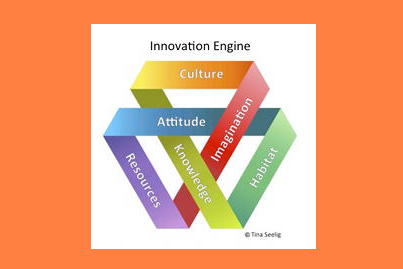This week's snow gave me the time to finish Tina Seelig's inGenius: A Crash Course in Creativity. Seelig is the Director of d.school at Stanford University. In this position, Seelig works with students and professionals for around the world as they develop the human assets that result in organizations (and individuals) who are more likely to be inventive and innovative in the solutions they design.
Seelig's Innovation Engine is a recurring theme and she explains throughout the book how creativity is a phenomenon that arises from these six intertwined factors. As an educator who is convinced that students who demonstrate creativity in the manner explained by Seelig will be better prepared for their unpredictable future, I see the Innovation Engine as a framework that can inform school planning.
In the current age of standards-based and data-driven education, we seem to focus very clearly on improving students' knowledge. The factors in the Innovation Engine are not, however, independent. Further, strengthening one alone will not promote creativity. By investing only one students’ knowledge, we are limiting the creativity they (and we) will need.
As Seelig summarizes:
- Your knowledge provides the fuel for your imagination.
- Your imagination is the catalyst for the transformation of knowledge into new ideas.
- Your attitude is a spark that sets the Innovation Engine in motion.
- Resources are all the assets in your community.
- Habitats are your local environments, including your home, school, or office.
- Culture is the collective beliefs, values, and behaviors in your community.
The questions that this work raises for educators (and others interested in education) are these:
- Do we want young people to have the capacity to bring creativity to the problems they will face? (If we do not, then we demonstrate we misunderstand their future.)
- Are we clear about the importance of each factor and are we actively working to ensure each is supportive of the development of creativity?
- How do we respond to criticisms from within or from outside the profession that those factors other than knowledge lie outside the domain of education.
As I see the laser-like focus on standards and outcomes, I am increasingly frustrated at the direction of education. Seelig’s work confirms the observations of others that (what can best be described as) a well-rounded experience is what students need. Shame on us for ignoring the breadth of curriculum our students need.


No comments:
Post a Comment